from:
Prestel museum guide, text by Denise Daenzer and Tina
Wodiunig: Native Museum of Zurich (orig. German:
Indianermuseum Zürich / Indianermuseum der Stadt Zürich);
Prestel edition; Munich, New York 1996; supported by
Cassinelli Vogel foundation, Zurich, by MIGROS percent for
culture, by Volkart foundation in Winterthur; ISBN
3-7913-1635-4
Karl Bodmer,
painter of natives
[1832: Karl Bodmer invited
for a trip to Boston]
[A German prince writing a letter to a member of Zurich
upper class]:
"Some days ago I got the news from Rotterdam that a
beautiful American ship is prepared there for leaving in
some days to Boston. I will take my trip with this ship I
think. I don't know if I told you already that Mr. Bodmer
from Zurich will be in my staff. He will surely make a big
quantity of great paintings. In animal painting he was not
so good, but considering his probes given to me it seems
that he can draw, and I will offer him this opportunity."
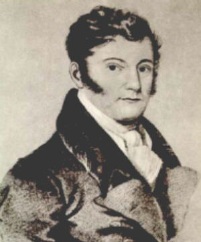
Prince Maximilian zu Wied-Neuwied, portrait [1]
|
|
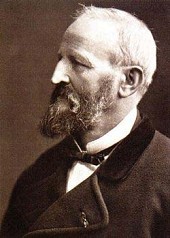
Karl Bodmer, profile, 1877 [2] |
[Karl Bodmer - trip with
prince Prinz Maximilian zu Wied]
These lines of April 1832 were written by prince Maximilian
zu Wied (1782-1867) to Heinrich Rudolf Schinz, a Zurich
scholar and later professor for Nature History at Zurich
University. Mentioning "Mr. Bodmer" this is probably Karl
Bodmer, born in Zurich at 11 February 1809, coming from a
weaver's and cotton commerce family, and his artist
education had been with his uncle Johann Jakob Meier, a
pupil of Heinrich Füssli, and this Mr. Füssli was one of the
most famous Swiss painters of these times. When young Mr.
Bodmer presented his first works as a painter and drawer
augmenting his reputation, prince Maximilian paid attention
to him. This Prussian aristocrat was enjoyed by natural
history from youth on, and - by a date with famous
geographer and researcher Alexander von Humboldt - he had
been visiting Brazil between 1815 and 1817. [Napoleon's wars
had been over in 1815 and whole Europe was suffering and in
ruins, but he went to Brazil...]
|
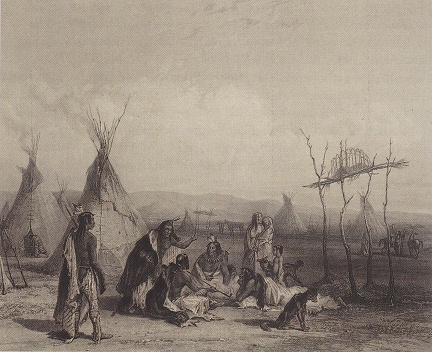
Karl Bodmer, platform funeral of a Sioux chief
Platform funeral
was the first funeral. It was applied like tree
funeral. The dead body was in furs and in the
height protecting the dead body from animals.
The dead body was mummified by this. Only two or
three years later the dead body (mummified) was
taken down and put into Earth with another
ceremony. But there were other tribes directly
burrying the dead body into Earth.
|
|
[In these times the reduction
of primary nations is going on already]
Maximilian's
second trip to the New World (1832-1834) was with young
Bodmer, and also a person named Dreidoppel ("Three Double"),
the prince's forester and hunter - and the aim of the trip
were the natives of upper Missouri. They hat colorful
clothes, singular weapons and mysterious rites who hardly
any white person had seen until these times. There were only
rumors. But they also had heard of the dreadful fights with
white settlers, of disastrous destructions and of the
introduced illnesses. Until that time there were about two
million natives in the Western prairies of North America,
but there were indications already that their culture will
not be possible to survive.
Karl Bodmer was not the only painter of these times painting
a record of these North American natives for future times.
Also Swiss man Peter Rindlisbacher who had emigrated with
his parents from Emmental to Canada, and also American
painter George Catlin, a critic of white reservation's
policy provoking many enemies, were documenting native
society and culture with illustrations.
[Trip until Fort McKenzie -
stay with primary nations of Mandan and Hidatsa]
The ship called Yellowstone was a fur trader ship, The
prince with his crew was traveling passing Ohio river and
Mississippi river reaching Missouri river up to the north.
And every time when the ship had to make a stay because of
wood and food supply the three were striving the region
collecting interesting plants and stones and getting into
contact with the dwellers. Bodmer mainly made layouts and
drawings. After a trip of 75 days they reached Fort Union,
the most important trade center of the fur companies. For
going on with the trip another more little ship was needed
passing only and clefted river landscape. Wind was only
rarely strong, so sailing was not often but the ship had to
be drawn with ropes or pushed with rods. Therefore the next
station was reached only in 34 days - the little hamlet of
Fort McKenzie where tour group stayed for some weeks.

Karl Bodmer, Fort Pierre at Missouri river
View of Fort
Pierre at Missouri river. At this point of the
river prince Maximilian and his two companions
had to leave the fur trade ship "Yellowstone"
because there were furs to trade bringing them
back to St. Louis - among others were 7,000
bison furs.
|
|
The original project going up to the Rocky Mountains staying
winter there was given up on half the way because there was
war between the Blackfoot and the Assiniboin [primary
nations] and the situation was really dangerous there.
Therefore the three travelers decided to go back staying
winter in Fort Clark more in the south. During the following
months Maximilian and Bodmer had enough opportunities for
talks and studies with life of the local natives of Mandan
and Hidatsa.
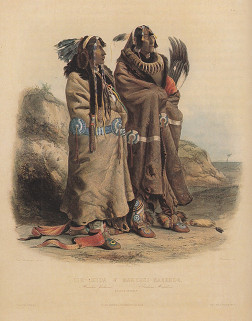
 Karl
Bodmer, two Mandan natives
Rapidly there
was the rumor spreading within Mandan population
that Maximilian zu Wied and Karl Bodmer had come
to get to know the local population and for
drawings. Some appreciated the pictures, others
were skeptical and got afraid contemplating the
competed pictures. Bodmer had a friendship with
Sih-Chida (Yellow Feather) who was as old as he,
a son of a died Mandan chief. The two young men
made some excursions, but mostly Sih-Chida liked
to be with Bodmer at the evening trying
sketching pictures of his life. Some of his
drawings are possession of Northern Natural Gas
Co. collection in Omaha [at Missouri river at
the east of Chicago].
|
x
|
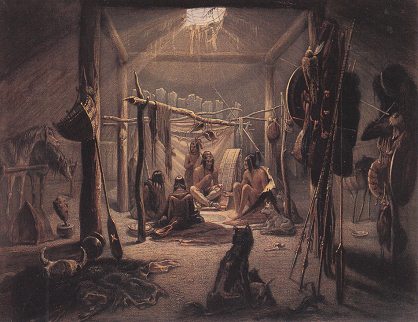
 Karl
Bodmer, Mandan natives in a pithouse
We thank Karl
Bodmer a unique authentic presentation of inner
life in this Mandan pithouse. The level was a
little deeper than earth lever reaching it by a
little tunnel. Behind the door which was made by
wooden frame and fur there was a wall with
willow twigs protecting from the wind. In the
center of the room was the fire with a stony
frame, and in the roof's cupola there was the
hole for the smoke [and this was the only window
of the house]. During bad weather the hole was
shut by a bully boat [round river boat]. Also
horses were often taken into the inner of the
house protecting them from cold and theft.
|
|
|
|
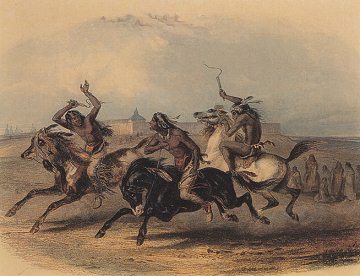
 Karl
Bodmer, horse race in the region of Fort Pierre
- theft of horses had a tradition, as also
exchanging children for horses
Horses were
introduced by Spaniards in North America [coming
from today's Mexico, and also Texas and
California were Spanish territories at these
times]. In 1630 already the first horses came
into native's possession. Most of them were
stolen and in some cases they were exchanged -
also for children. Southern Ute and Comanche
were rated as the most successful horse thieves
and exchanged the animals with the northern
tribes. At about 1750 most of the prairie
natives possessed horses, and since about 1775
there were also bigger herds in the Northern
Plains.
|
|
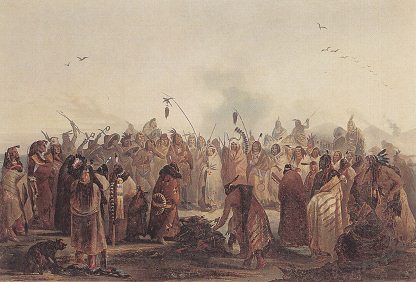
 Karl
Bodmer, a scalp dance of Hidatsa natives killing
two horse thieves who were stupid getting
catched
Theft of horses
was a well loved test of courage gaining a big
honor - or losing the scalp and mostly also
losing life getting catched. Here in Fort Clark
two horse thieves of Assiniboin primary nation
were killed. The chief slayed the horse thief
and the chief's wife had the scalp fixed on the
top of a rod. The second scalp was shown by
another woman. When Hidatsa with their black
colored faces were acting with their drums and
rattles, the women and men began singing and
dancing.
|
There were endless drawings and watercolors during the whole
trip with impressive landscape and genre paintings,
illustrations of dances and rites, with studies of plants
and animals, with sketches with weapons and tools, and above
all great portraits and presentations of groups of natives.
After a hard winter - with emergency food of cornmeal and
biscuits also for the prince for some time - the group was
beginning traveling home since April 1834: with boxes full
of clothes, objects, plants, minerals and precious objects
of arts and cults which were collected and recovered by
exchange or as a present.
[Going home and exhibitions
of the objects of Mandan and Hidatsa culture - picture
atlas with Bodmer's pictures]
A part of the good was destroyed by a fire on board of the
ship, but the result of the scientific trip remained well
varied. Coming home on 25 August 1834 in royal castle
Neuwied in Germany the objects were well investigated and
systematically classified by prince Maximilian. Today most
of these objects can be found in the American sections of
ethnological museums of Berlin and in Linden Museum ("Lime
tree Museum") in Stuttgart - with the exception of the
nature study objects [plants and seeds].
The voluminous expedition report published by the prince
under the title "Trip to Inner North America in The Years
1832-1834" (orig. German "Reise in das Innere Nord-Amerika
in den Jahren 1832-1834") was published step by step between
1839 and 1844 in German, then in French and then in English
editions, with Bodmer's illustrations (p.10).
Add to this a picture atlas with Bodmer's pictures was
published in two volumes, and his colored copper engravings
were famous already. This picture atlas was produced in
collaboration with Zurich engravers Bayer, Hürlimann and
Weber, and also with French and English specialists.
[Bodmer's pictures
auctioned in 1959 in New York, with Maximilian's travel
diaries and printing plates - museum in Omaha - estate in
Newberry Library in Chicago]
After upcoming of photo cameras the pictures of Bodmer's
trip in America were forgotten more and more until the
originals came up in a revision in the castle library of
Neuwied. Anthropologist Josef Röder recovered them, and in
1959 New Yorker artist merchant M. Knoedler & Company
purchased the whole royal collection, with Maximilian's
travel diaries and the original printing plates of Bodmer's
drawings inclusive. Since 1986 the collection is in
possession of Joslyn Art Museum in Omaha. A little part of
about 40 sketches and watercolors is in Newberry Library in
Chicago which came from an auction of Bodmer's estate after
his death in Paris.
[Copper engravings]
Today the original Bodmer's picture atlas can be seen in
some European and North American museums and collections but
is rarely complete. Aside of this there are some different
sequences of Bodmer's native drawings and paintings coming
from different models of the original edition. Also Native
Museum of Zurich has got a precious collection of such fully
colored copper engravings.
In 1991 a London editor published a limited new edition of
81 copper engravings of Karl Bodmer with the title "Bodmer's
America" which is sold in Europe by Knobel Art Collections
in Zug (Switzerland). The 125 numbered pictures of this new
edition are made with the original printing plates and were
colored by hand according to the original models.
After returning home prince Maximilian wrote about Karl
Bodmer's work: "I have my doubts if there had ever been made
a collection of portraits and traditional clothes in this
manner how Mr. Bodmer made it. At least there does not exist
anything similar about North America, and the pictures have
really got a speaking similar style."
Bodmer never left Europe again. Some time later he changed
to France to Barbizon near Fontainebleau being member of a
local group of artists later known as "School of Barbizon",
and they were quiet successful painting in a style of
intimate landscape. Bodmer succeeded with watercolors and
landscape paintings, and also etchings of plants and animal
selling them to newspapers and reviews. Besides he worked
also for book editors illustrating works like the "93
fables" of La Fontaines and Victor Hugo.
[Last years in Paris -
death in 1893]
His last years of life Bodmer lived with his wife in a
little flat in Paris at Deferent Rochereau Square 24 where
he died at 30 October 1893, mostly forgotten and
impoverished. (p.11)









 Karl
Bodmer, two Mandan natives
Karl
Bodmer, two Mandan natives

